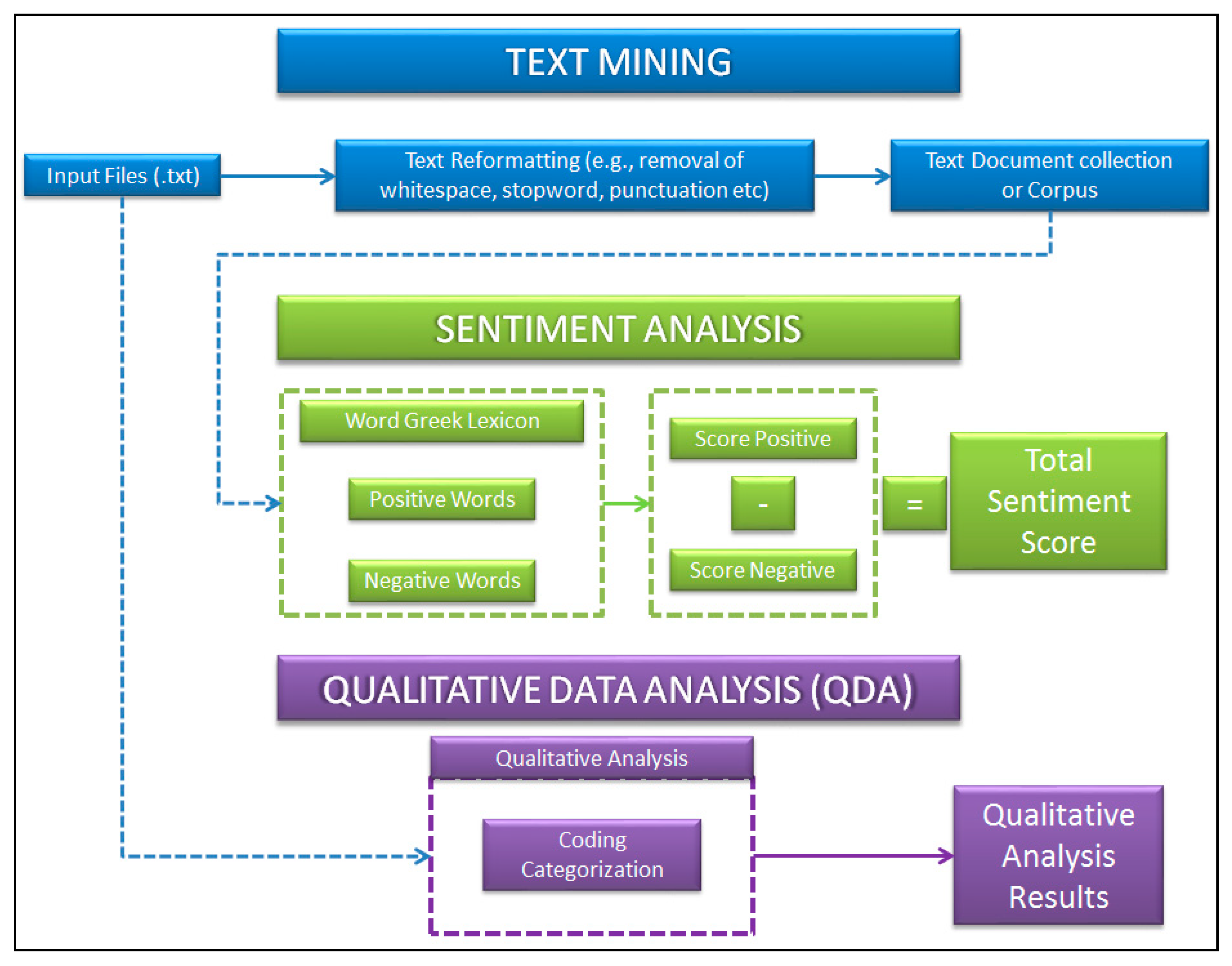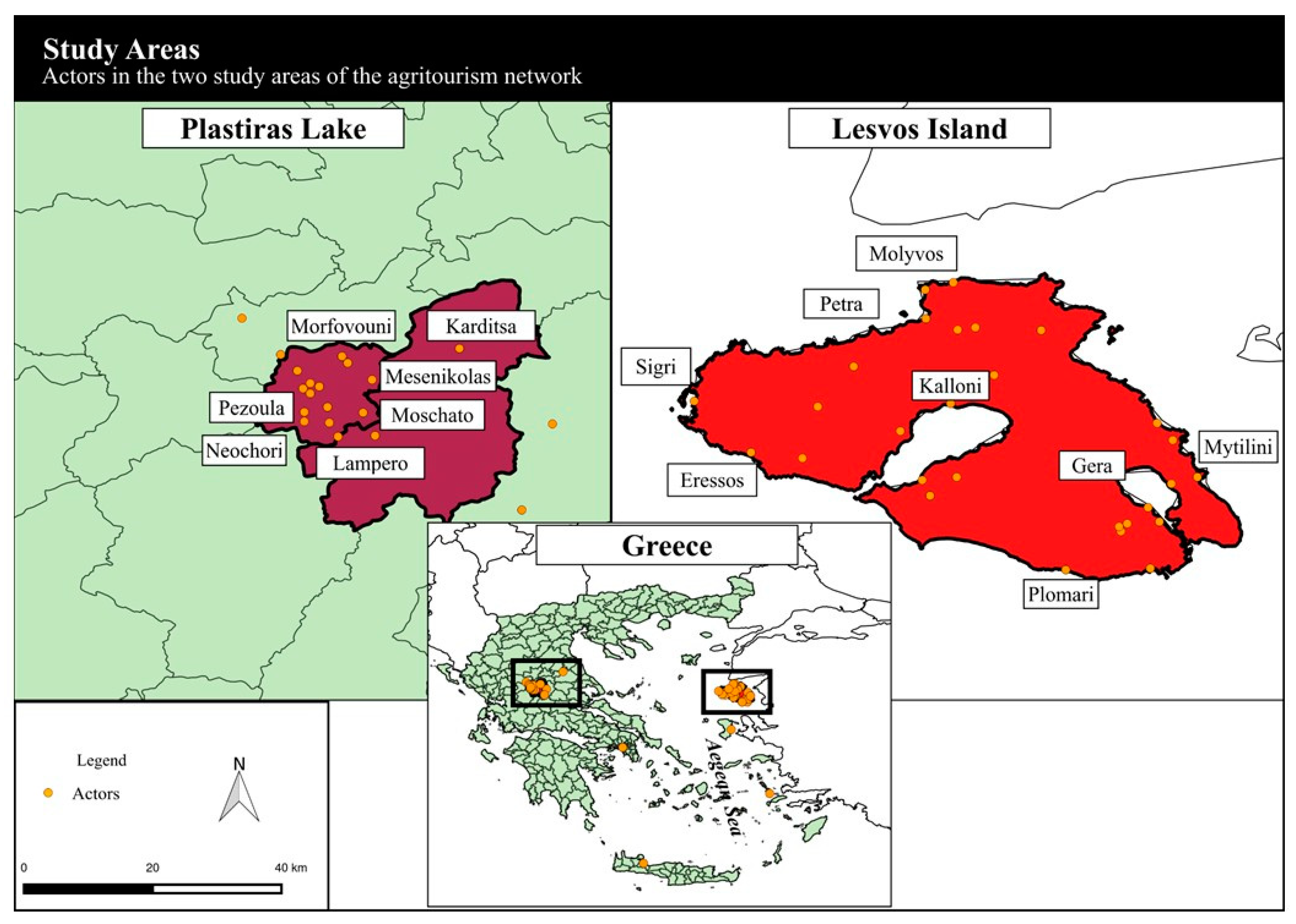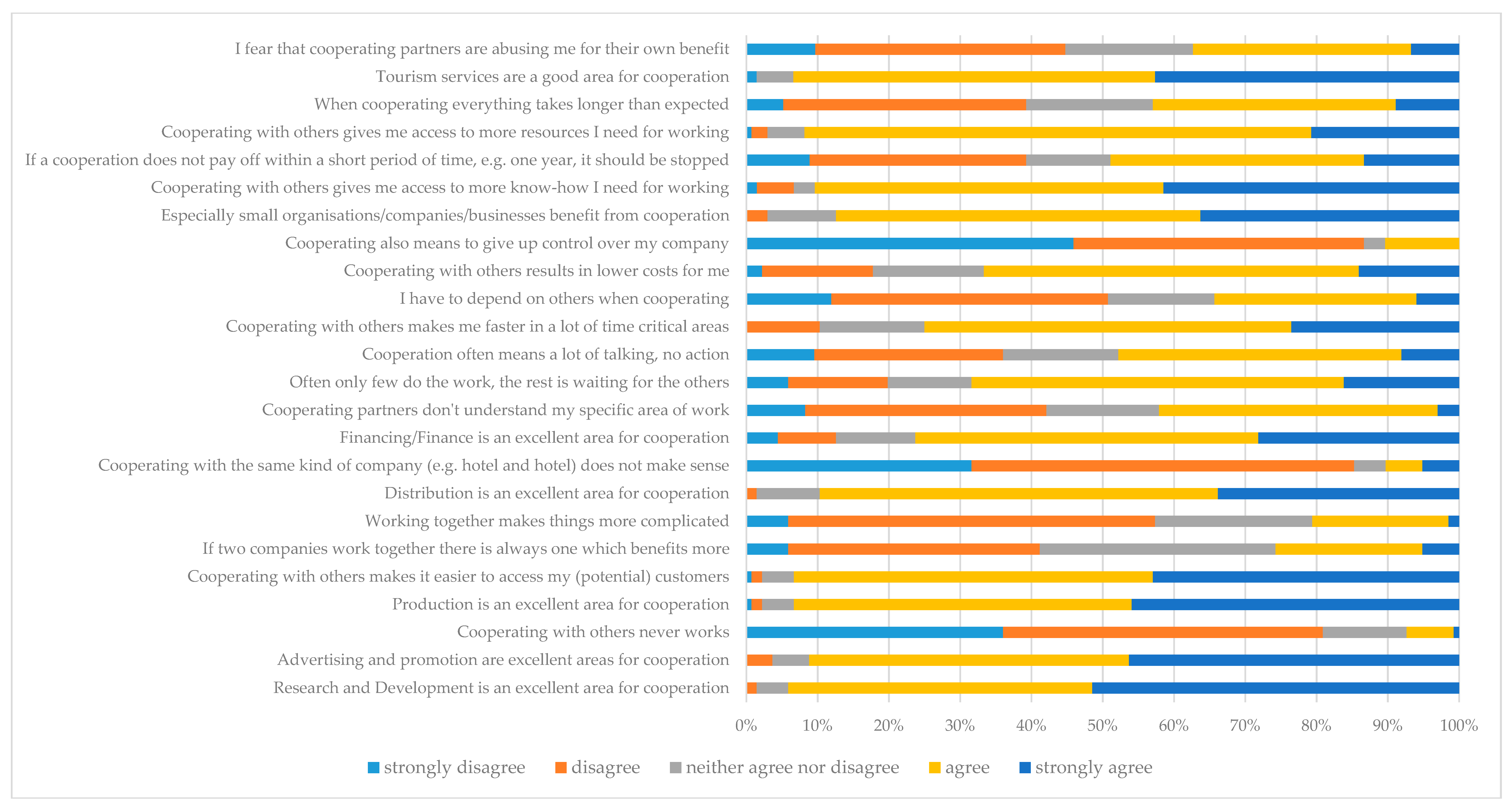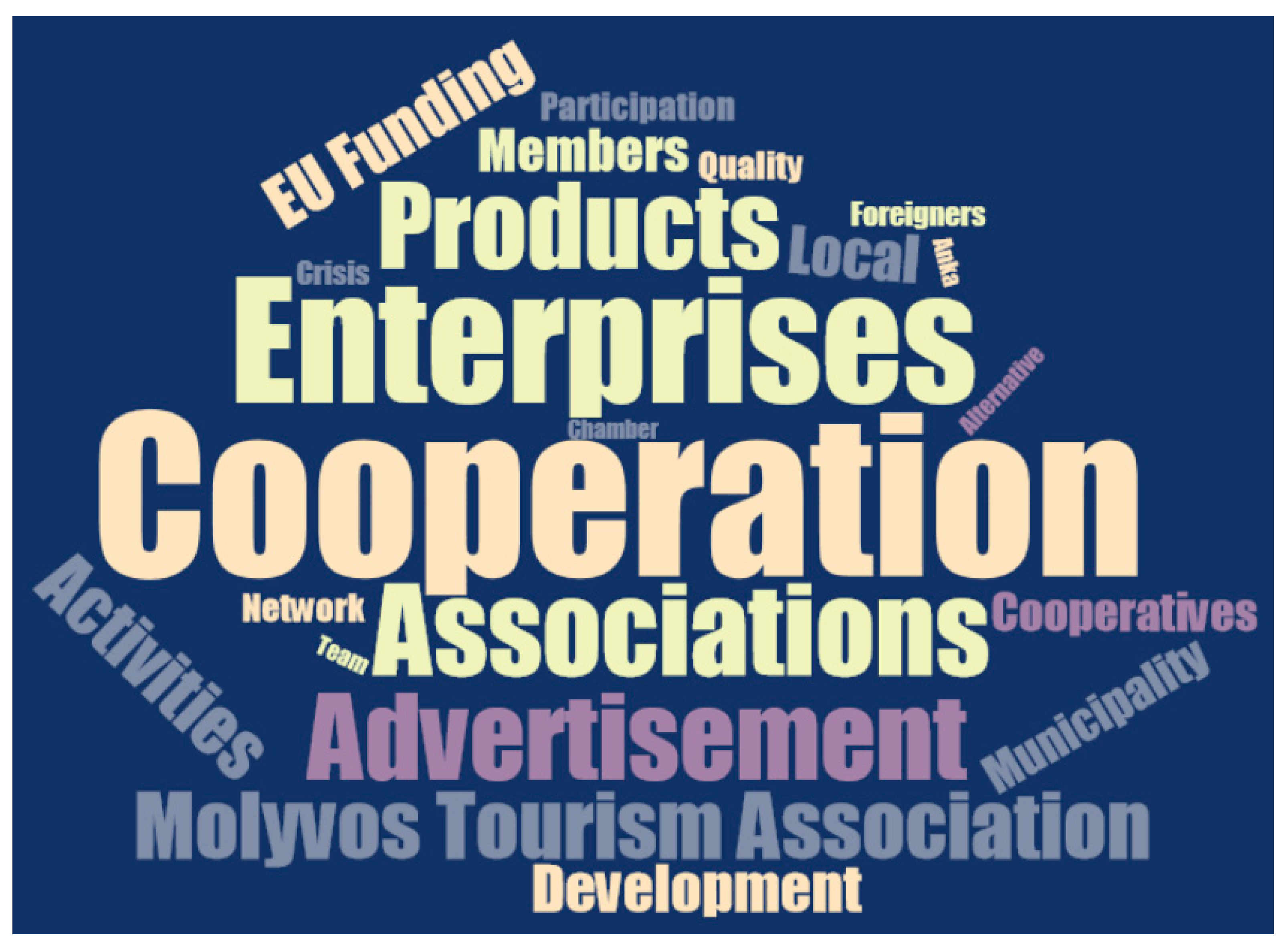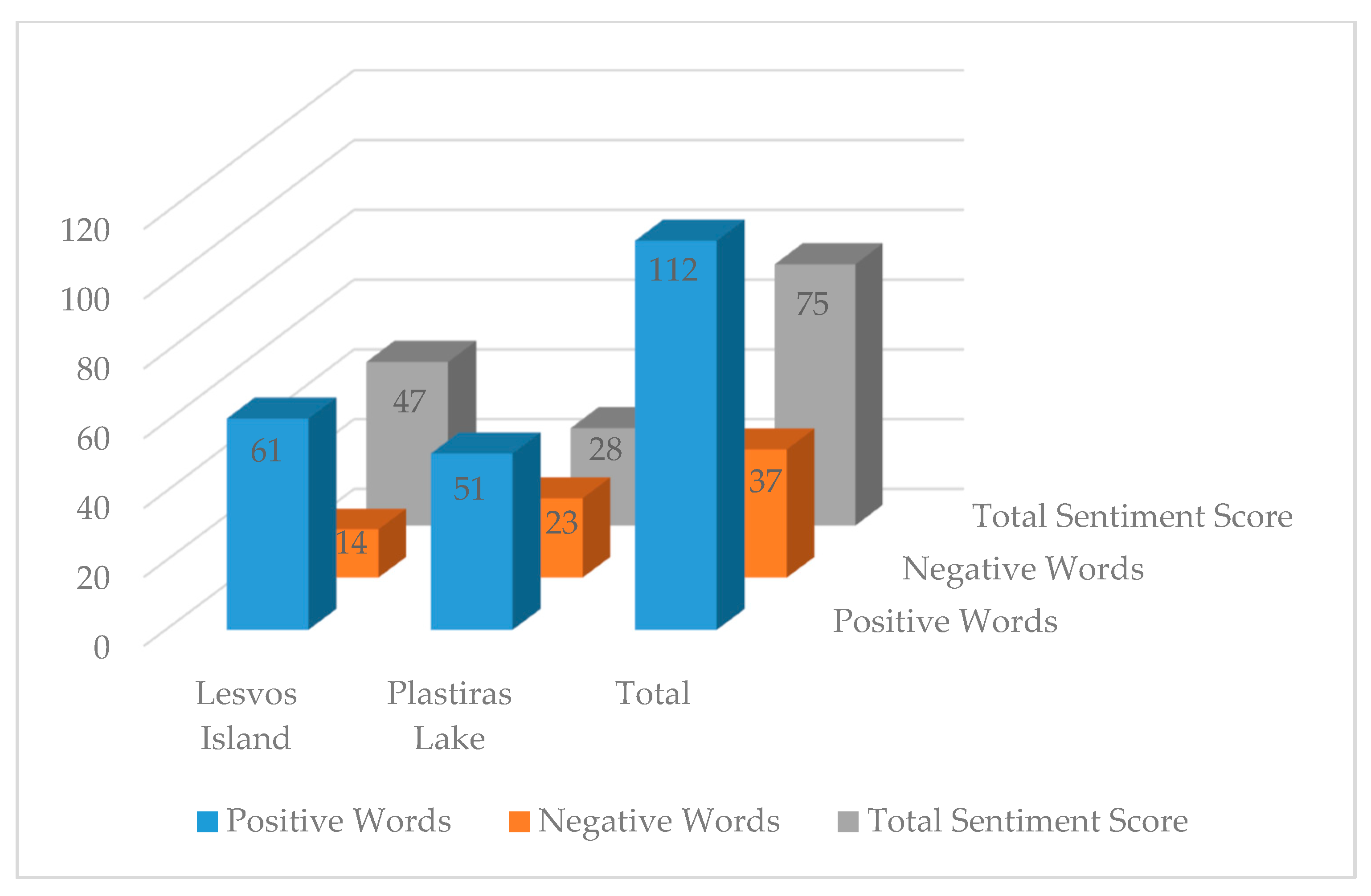1. Introduction
While many definitions and activities associated with agritourism are recognized in the literature, researchers have struggled to develop a classification system that can integrate all definitions and characteristics [
1]. Phillip, Hunter and Blackstock (2010) sought to provide clarification by developing a typology of agritourism based on a relationship with a working farm. This was determined by the type of direct or indirect contact agriculture provided for the tourist, as well as the authenticity of experience in terms of whether there was engagement with actual farm tasks [
2]. Further empirical research by these authors [
3,
4] and others e.g., [
5] shows that the typology possesses considerable validity [
6].
Potočnik-Slavič and Schmitz (2013), by identifying the different understanding and common characteristics of agritourism in nine European states, concluded that existing legislations are “
distinctively different in all surveyed countries”, meaning that “
there still does not exist a common understanding and operational definition of farm tourism at an EU level” [
7]. As also stated by Streifeneder (2016), only a few European countries legally define and regulate agritourism, or address it with a national governmental body [
8]. According to Pulina et al. (2006: 1007), “
Within the European legal framework, rural tourism and agrotourism are considered as a synonymous” [
9], although there seems to be a growing consensus that rural tourism is a broader spatial term that encompasses a diversity of activities offered in rural settings [
10,
11,
12,
13,
14].
According to Karampela et al. (2016: 165), “
Agritourism is no longer just an activity where farmers provide accommodation … Qualitatively, the services involved in agritourism products are offered more often in smaller packages of agritourism experience and not from the same enterprises. Some enterprises offer accommodation only, others offer services only, more and more often involving ‘agritourism professionals’ rather than farmers” [
11]. This kind of product requires a better cooperation between enterprises and networks that provide an opportunity for the exchange of knowledge. As in agritourism, two distinctive sectors coexist, and the importance of cooperation and networks in its sustainability is underlined by many authors, e.g., [
15,
16,
17,
18,
19,
20,
21].
On the other hand, Streifeneder (2016: 262) notes that “
mixing and confusing authentic agritourism and its meaning with other touristic activities is detrimental to this sector” [
8]. Ciervo (2013) labels this “
commercial agritourism”, and prescribes that [
22] “
on-farm activities and offers with specific touristic characteristics—the swimming pool is one striking feature… should be critically examined and also no longer officially labeled agritourism”. Based on the same approach, Gil Arroyo et al. (2013: 46) analyzed perceptions of three stakeholder groups (providers, consumers and extension agents), suggesting that “
activities offered on non-working agricultural facilities or those in which the setting is only used for landscape purposes should not be promoted as agritourism to avoid further confusion” [
5]. Taking into consideration that respondents were given a somewhat restrictive list of possible definitional elements to explore the meanings of agritourism, they recommended broadening future studies that could consider employing qualitative methods of inquiry, such as face-to-face interviews or focus groups, and thus enable a more insightful construction of a shared understanding of agritourism.
This study attempts to fill the gap in the literature by analyzing agritourism perceptions of supply-side actors with personal, in-depth interviews and open-ended questions related to agritourism sustainability and aspects of cooperation between and among actors. Based on the assumption that destinations with different geographic characteristics have different features and products, two different destinations as for its accessibility and tourism recognition were selected for comparison: an island, and a lake in a mountainous region of Greece. The importance and development of agritourism on islands are understudied (especially in the Aegean Sea [
23], where the island of this research is located) although they have been explored in detail by other authors [
11]. Furthermore, the benefits of agritourism in mountainous areas have been broadly referred, e.g., [
24] (especially its development in Greece [
12,
13]). The data collected during these interviews were analyzed using a combination of qualitative methods, to diminish the subjectivity of the analysis. The methodology architecture which is developed and presented in the section below with its limitations can be adopted in various sectors and topics.
2. Materials and Methods
2.1. Text Mining and Analysis in Literature
Text mining can be broadly defined as a knowledge-intensive process through which a user interacts with a collection of documents over time to extract useful information from unstructured textual data by identifying and exploring patterns [
25]. There are plenty of different approaches to performing text analysis. Not all available systems and techniques aim to extract the same type of information, or with the same granularity. Some are oriented just to find the overall polarity of a full sentence, paragraph or document, while others aim to find the polarity of a product or service feature basis [
26]. The field that analyzes people’s opinions, sentiments, evaluations, appraisals and emotions towards entities such as products, services, organizations, individuals, issues, events, topics and their attributes is called “sentiment analysis” or “opinion mining” [
27].
Hopken et al. (2017), following the categorization of sentiment approaches by Tsytsarau and Palpanas (2011), discuss previous research in the field of hospitality and tourism, and present them as four major categories [
28,
29]: (1) supervised machine learning, (2) dictionary- or lexicon-based, for more details see [
30], (3) unsupervised machine learning, e.g., [
31] and (4) semantic approaches. A few scholars have compared the performance of both machine learning and lexicon-based methods see [
32]. Typically, sentiment analysis reaches characterizations of positive, negative or, sometimes, neutral, for the textual sources at hand [
33]. During the last decade, applications of text reviews have grown very quickly in the tourism sector, e.g., [
34,
35,
36,
37]. One notable example is the study of Capriello et al. (2013), which provided meaningful insights about national markets by assessing consumer sentiments of farm-stay experiences across four national settings and demonstrating three alternative methods to analyzing large volumes of qualitative data quantitatively [
16].
An extensive literature review from Mostafa (2013) suggests that most sentiment analysis applications might be classified into four distinct categories [
38]: (1) product reviews, (2) movie reviews, (3) stock market predictions and (4) political orientation extraction, e.g., [
39]. According to Markopoulos et al. (2015), the greater part of the research in sentiment analysis has been focused on online texts written in English and especially on movie and product reviews. Thus, the literature on other languages and domains is rather limited [
40]. As a means of resolving this, they applied a machine-learning approach (which has been shown to be more accurate than semantic orientation approaches) for hotel reviews from the Greek version of TripAdvisor. Kalamatianos et al. (2015) pointed out that the Greek language has not been examined sufficiently in tasks related to sentiment analysis, mainly due to a shortage of appropriate datasets specialized in Greek. In their analysis, they investigated methods for extracting sentiment of individual tweets as well population sentiment for different subjects (hashtags) by using the first sentiment lexicon for Greek [
41].
Another method of text analysis is qualitative data analysis (QDA), which involves “
careful, detailed, systematic examination and interpretation of a particular body of material to identify patterns, themes, biases and meanings” ([
42]: 304). Codes or coding categories are used as a means of sorting the descriptive data that have been collected so that the material bearing on a given topic can be physically separated from other data. This method involves a systematic unitizing of textual data amongst which the researcher will look for relationships. The results of this method are frequently presented numerically. Qualitative research as an alternative methodological approach has gained acceptance in many fields, such as education, sociology, anthropology and consumer behavior. More recently, researchers have questioned quantitative research because it cannot fully address questions of understanding and meaning [
43]. Powell and Kennell (2016) use QDA methodology by developing a series of keywords following a review of the dark tourism literature for a content analysis of destination marketing organization websites representing Europe’s ten most visited cities [
44]. Musa et al. (2010) examined rural home-stay tourism as one of the Malaysian government’s key efforts to diversify its cultural tourism products and explain the different phases of travel experience and its components by using QDA among Chinese and Malay students’ experiences [
45].
This study introduces a combination of methods, including (a) text mining, (b) sentiment analysis with the use of a lexical database and (c) QDA for analyzing the agritourism and cooperation perceptions of actors in a sector for which there is little research. The first two methods were oriented to finding the polarity and the sentiment of a word, while the third one aimed at finding the polarity of the overall agritourism product/service and cooperation comments. From a methodological perspective, all three methods provided unique insights on these themes.
2.2. Research Approach and Analysis
The research approach includes quantitative and qualitative aspects of agritourism and cooperation and is structured in three stages. In the first stage, preliminary survey of different agritourism destinations provided data from several sources collected, including statistical authorities and ministries of tourism, official tourism organizations and associations, tourism and agritourism networks and agritourism enterprises. The final result was a database with the appropriate tourism actors and products from the destinations, their roles in the complex tourism system and their possible relations with other actors and products.
In the second stage, actors from the preliminary survey were contacted by e-mail and/or telephone to clarify if they were appropriate for the purposes of the study. After this initial contact, a face-to-face appointment was arranged for in-depth interviews with the use of semi-structured questionnaires including the following sections: (a) type-profile of agritourism unit/enterprise (type of services offered—economic activities, promotion methods, websites, online reservation and e-shops), (b) profile of the respondent (e.g., main occupation), (c) open-ended questions for agritourism and rural tourism definitions, (d) a five-point Likert scale for positive and negative aspects of cooperation and (e) free space for additional comments from the respondents about their experiences with agritourism and cooperation for the sustainability of the sector. A snowball survey method was used for sampling, where the first set of actors identified other agritourism actors and the process was repeated until the sample was saturated.
In the third stage, the database of the first stage was enriched with new information derived from the respondents and the snowball survey.
The analysis of open-ended questions and additional comments was performed with the use of text mining, sentiment analysis and qualitative data analysis (
Figure 1). Two main phases of text mining took place: (1) preprocessing and integration of unstructured data, and (2) statistical analysis of the preprocessed data to extract content from the text [
46]. For the purposes of the first phase, txt files (160) of the interviews were constructed from a word document where all the open-ended questions and comments were included. The total size of all files was about 650 KB, and special attention was given to encoding in UTF-8 as Greek characters existed in it. For the second phase of the mining, three libraries were installed and used in R open source language: TM (for text mining), stringr (for string operations) and RQDA (for qualitative data analysis). The text mining procedures that took place were:
- (1)
Convert the entire document to lower case.
- (2)
Parse the data, discarding spaces, punctuation and other non-alphanumeric characters.
- (3)
Eliminate articles and remove stopwords (extremely common words in the English and Greek languages, such as “and”, “or”, “not”, “in”, “is”, etc.) and other words that convey little or no information.
- (4)
Create the structured data, a table where each term in the text data becomes a variable with a numeric value for each record [
46].
The output of this process produced a matrix with words and their frequency values representing how often each word occurred. Not all words were equally informative of the underlying semantic structures of texts and some words were rather useless for this purpose, so there was an iterative process of removing certain words from the “
bag of words” [
47]. The final result was a world cloud of the 22 most frequently found words in the data set, which is presented in next section.
The structured files produced above were used for sentiment analysis with the evaluation of each word deriving from the first sentiment lexicon for Greek (available at
https://github.com/MKLab-ITI/greek-sentiment-lexicon; the approach for constructing the lexicon is described in [
2]—subsection 5.4.1). This lexicon contained 2,315 entries, evaluated by four independent raters, with the rate of every entry being subjective. Taking into account the four different ratings of polarity that existed in the lexicon, two more files were created, one with positive sentiment words and one with negative. The subtraction of the number of negative from positive opinion words produced the final sentiment score. It is worth mentioning that having a sentiment lexicon (even with domain-specific orientations) does not mean that a word in the lexicon always expressed an opinion or sentiment in a specific sentence. For example, in “I am looking for a good car to buy”, “good” does not express either a positive or negative opinion on any particular car [
48].
In the final step of analysis with the use of RQDA, coding was added to the structured dataset not only for qualitative analysis but also for sentiment analysis of whole opinion sentences. Dimensional analyses with a procedure of first and second order led to the definition of variables and values that were used for classification and quantification.
2.3. Case-Study Areas and Sample
As referenced in the introduction, this study was based on the assumption that destinations with different geographic characteristics have different features and products. Thus, two destinations in Greece with different characteristics as for its accessibility and tourism recognition were selected for comparison, one of the Aegean island, Lesvos, well-known internationally, especially in recent years from media for the refugee crisis, and one continental region Plastiras Lake in the Agrafa mountains—“
the name of what is still the most inaccessible and least developed part of the country” [
49]—at the central part of the country (
Figure 2). The two field studies were conducted during months in which the highest number agritourism enterprises are open and in their high season in the selected case-study areas, the first during July–November 2015 and the second during June–September 2016. The specific characteristics of the case-study areas and their samples are described in previous articles analyzing agritourism networks [
18] and assessing the impacts of agritourism at local level by combining different factors [
50].
4. Discussion
Perceptions from the supply and demand side, including tourists, visitors, locals, stakeholders and entrepreneurs, are important for the promotion of all kind of products. This is the reason for finding extensive literature analyzing qualitative data and especially reviews of tourism experiences (demand side) from online forums, a process without cost in comparison to face-to-face interviews. Until now, these kinds of papers were published mostly in non-tourism journals and books, as cited by Riley and Love (2000) in a previous research [
43]. In this article, agritourism and cooperation perceptions were discussed from the supply side of different types of actors, the data were selected from in-depth personal interviews and large volumes of qualitative data were analyzed quantitatively using a combination of methods including unsupervised text analysis, lexicon-based sentiment analysis and supervised qualitative data analysis.
For 40% of our sample and for Streifeneder (2016: 252), “
authentic agritourism is carried out on a fully functioning working farm where the agricultural activities are predominant over the touristic ones, and where familiar and direct contact with the hosting household and its members takes place in an unaltered agricultural environment” [
8]. This is the opposite of what Flanigan et al. (2014: 403) suggest: “
While the results of our research cannot be deemed as representative as a whole, understanding differences and commonalities in perceptions within our case study suggests some interesting lessons for agritourism management and wider agritourism policy. For example, grant support to agritourism enterprises could be extended beyond those on working farms, if the product still made a contribution to public understanding of agriculture. Agricultural interest groups might wish to pay closer attention to how agriculture is portrayed by agritourism products, as one way of managing public perceptions of their industry” [
3].
According to Gannon (1994: 55), authenticity “
provides a competitive edge” for a rural tourism experience and must include “
genuine quality, originality, uniqueness, a sense of place and a sense of pride” [
52]. Our interviewees’ opinions about agritourism and cooperation in the open-ended questions and comments were overall positive and in line with a recent study by Dubois et al. (2017), which underlined that “
agritourism is a muddled concept and/or image between realities and stakeholder expectations” [
53]. This was also underlined in Kaaristo (2014), who stated that “
the rural sound idyll is a disputed ground… there are many different stakeholders with their own interests in mind and the guests’ ideas of the suitable aural environment does not always match with the one of the hosts” [
54].
Many of the wine, ouzo and olive oil producers recognized the potential value of tourism to their enterprises and the region, and highlighted the need to compete in terms of quality (which appeared in the word cloud) and uniqueness, not on costs. They suggested that this would involve creating a personal connection for consumers that goes beyond just the local products (also appearing in the word cloud) they buy, but also the landscape, scenery and unique experiences during their time in rural areas, which would likely foster further engagement with local producers and tourism activities (as also cited by Scherrer et al., 2009, in their research on wine tourism in the Canary islands and the need for expansion of the destination image) [
55]. Such a cooperation would add value to visitors’ experiences while keeping them in the area for a longer period of time [
56].
As for the comparison between agritourism and rural tourism, the results are also in agreement with other researches, including Pulina et al. (2006) on synonymous terms [
9], and Barbieri et al. (2015) on rural tourism as a broader spatial term encompassing a diversity of activities offered in rural settings [
10]. It has also been expressed by others [
7,
8] that “
there is no legislation framework for these kind of products but…with synergy and cooperation are becoming powerful”. Furthermore, the survey reveals that the development of agritourism and rural tourism are closely linked to the existence of a legislation that permits funding (e.g., the LEADER Initiative), as also cited for other rural areas by Iakovidou et al. (2002) and Paniagua (2012) [
57,
58].
The low involvement of farmers in tourism in the research area (19%) is in line with previous research in rural Greece indicating that less than one out of five accommodation owners are farmers [
13,
59]. It might be why Koutsouris et al. (2014: 100) underline that “
tourism as a diversification strategy on the part of the local farming population is not remarkable” [
59]. Therefore, half of the sample is uncertain and pessimistic about the future and the sustainability of their enterprises, which Zarokosta and Koutsouris (2014) point out in their research of local actors’ perceptions and behaviors (with emphasis on networking and cooperation) [
60]. They also refer to “
the lack of a culture of cooperation” as in the Plastiras Lake case-study area. However, according to a study by Weiß et al. (2016: 24),
“farmers see that by cooperating with a logistics partner, who (collects and) delivers their products, they are able to concentrate on their farming business…In turn, logistic partners can diversify their range of products and become more attractive for clients in and potentially outside the region” [
61]. Fostering logistic cooperation contributes to a positive image of the region. This is described as a weak “
bridging type of social capital—the capacity of groups to make links with others that may have different views, particularly across communities” ([
62]: 633), or as external [
6,
63]. On the other hand, willingness is expressed to strengthen forms of bridging social capital, networking and trust.
The results of our sample investigating promotions, the number of languages in websites and online bookings confirmed that cooperation is based on personal relationships. Existence of resources does not necessarily make an area a successful and sustainable tourism destination. Cooperation projects emerge with difficulty if participants do not invest enough time, opinions are too divergent or benefits are not immediately visible or comprehensive [
61]. It seems that there is a gap between theory and practice, as network managers still spend most of their time and energy on traditional power-related tasks, such as the “top-down” provision of information, and thus focus is needed on how tourism networks can be sustainably managed [
64]. The successfully complex network of interdependencies and relationships at the “destination triangle”, made up of governance, supply side and demand side, and the exact roles of intra-destination network relationships and relationship management are improving the quality of tourist experiences [
65] posing a sustainable destination. As referred from enterprises of our sample, if institutions do not encourage trust between actors (or in other words they possess weak institutional social capital), it is not possible for enterprise networks to perform efficiently and obtain scale economies and increasing returns, as Vázquez-Barquero and Rodríguez-Cohard (2016) also identify and underline for the role of institutions in endogenous development [
66]. There is a need for an area-level management authority that will be able to listen to actors’ matters and help them in planning for the future. The lack of a culture of cooperation in agritourism products, where agriculture and tourism should coexist and cooperate, hinders such an effort.
5. Conclusions
The literature underlines inconsistencies in understanding and defining agritourism. Sometimes the term is described as problematic for the development of marketing and for making this activity more accessible to the public. The perceptions of the term, its definition and the legislation framework in a country and/or common legislation framework between countries are important for enterprises and stakeholders. However, the overall results from cooperation networks between different kinds of enterprises and stakeholders are also important, as networks in agritourism seem to be a paradigmatic case, even the informal ones. This study attempted to fill a gap in the literature by recording agritourism perceptions and aspects of cooperation from supply-side actors with personal in-depth interviews and open-ended questions. The approach revealed similarities and differences between two geographic cases, but also provided an overall picture of agritourism products and cultures of cooperation. Because of the high amount of subjectivity in analyzing and interpreting the data, classifying sentiments will never be perfect, but the combination of qualitative methods for analyzing the data that were collected attempted to diminish subjectivity and useful results emerged. The methodology which was developed and presented in detail with its limitations can be adopted in various sectors and topics. Similarities in perceptions would be expected because of the similar patterns of agritourism development in Greece compared with other agritourism destinations in Europe. It seems that a common understanding is important for cooperation and networking; however, training is needed, not only for effective promotion of agritourism but also for cooperation techniques, benefits, trust-building mechanisms and discovering the best practices for sustainability. Furthermore, a more flexible association stakeholder might be needed with “bottom-up” management, listening to the conflicting interests of the different groups, “compiling the translation between them”, and providing relational management of the “destination triangle” to strengthen the competitive position of the destination and its sustainability.
